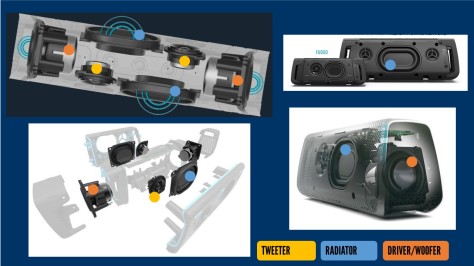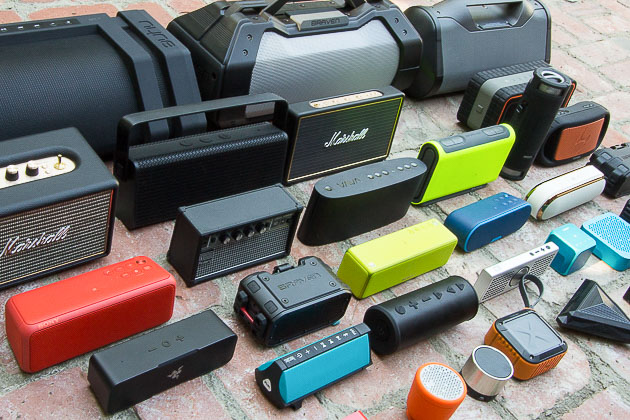We live in a generation where the mobile devices are a central part of our life. The importance of the mobile has brought an explosion in portable companion devices such as the portable chargers, Bluetooth headsets, speakers, etc. Portable speakers are not a new concept for folks who would have been used to boom boxes and battery equipped radios in the 1970s. These speakers were part of a major cultural change when it came to street music.
The popularity of the IPOD brought a new wave of portable audio devices in the likes of sound docks. However for Android which joined the party a bit later found only limited options for sound docks due to the change in the connector (mini USB to Micro USB), and the variety of device types. The emergence of Bluetooth as a medium for playback, and combined with music apps on smart devices truly made universal portable audio devices to come into the market.
The portable wireless audio market since then has been growing fast, and these devices are offering continue to improve on the quality audio in a smaller foot print. In order to achieve these portable wireless speaker manufacturers have designed in extensive concepts that allow maximum use of the small space of the speaker cabinet.
For anyone who has used audio equipment will know that size of the speakers, no of speakers, type of speakers, power of the amplifier, etc are not pure indicators for good quality sound. The speaker designers have to tune the speakers to ensure it can handle a full range of frequencies, and the circuitry and software must also be designed to ensure compressed audio is processed, amplified to make use of the speaker hardware.
Unlike home theater systems or mini hi-fi systems, which feature dedicated sub woofers or speaker units for bass, the portable speakers with the size limitation are challenged in handling playback of the full spectrum of frequencies. Hence if your expectation is that the portable wireless speakers are going to give the same quality and loudness of GOOD home theater systems or mini hi-fi systems, you will have to tone your expectations 🙂 , but things keep improving so some of these portable speakers can provide far better output than the largish computer speakers we used in the past.
So here is a few useful notes on the basics of a portable wireless speaker that can help you buy like a pro!
SPEAKER DRIVERS
Since we refer to the complete unit as the “SPEAKER”, i will refer to the individual speakers in this unit as “DRIVERS”
Modern good quality portable wireless speakers will feature some of the following drivers.

- Full range drivers – These are all purpose speakers, which will TRY to handle all frequencies with on speaker.
- Mid Range drivers – These speakers will usually handle most of the vocals in the music (300-5Khz)
- Woofers – These are used to handle low frequencies (40 – 1kHz)
- Tweeters – These are used to produce high frequencies (2kHz – 20Khz)
- Passive Radiators (also called drone cones) – The air forced by the main woofers and speakers are “re-used” and pushed through the radiators (a piece of audio equipment that specially useful for bass frequency), which add to improved bass response. Most radiators are passive in nature, as in they do no use any electrical power (they are not connected to the amplifier), but are entirely powered by the pass through airflow.
- Bass Reflex port – This is more common approach to improve bass responses on speakers. Many small PC computers feature this technology, which allowed superior bass outputs from standard speakers. Here again there are variation, but seemingly with smaller footprints the passive radiators seem to offer better bass responses than a reflex port, as bass reflex ports are harder to design (but cheaper to implement)
A good read for passive radiators – http://www.centerpointaudio.com/passiveradiators.aspx
If you buy a speaker and it only has two same size drivers, then its mostly likely having full range speakers, where both drivers will try to play all frequencies. The quality of the full range driver will decide how well the total speaker system plays different genres of music, but most often such speaker will be bass limited (bass will be muffled and lacking the thump), or if the manufacturer tunes it it may lack the mids (which will effect the vocals).
Many knock offs (copies/fakes) of branded products or cheap speakers will usually feature full range speakers, and possibly a simple bass port.
Some higher quality speakers may bring in a more balanced set of drivers that combine the different types (mid range drivers, woofers, radiators, tweeters) to provide good quality audio which can also handle different music genre’s.
SPEAKER AMPLIFIER and AUDIO PROCESSOR
The drivers/woofers/tweeters/radiators are one part of the speaker, but another essential part is the sound processing hardware and amplifiers. The speakers also consist of the DSP (Digital Signal Processor), the DAC (Digital Audio Converter), and codecs. The quality of the hardware and software used here, along with the tuning of these to match with the drivers/woofers will be key for the overall performance of the speaker.
This is why you will find that some speakers touting very powerful speakers may not sound so great for different music genre’s, as lack of software optimization and poor sound processing can completely cause the speaker drivers to be useless. Some vendors may add buttons for controlling treble, bass but you may find when playing wireless you will hardly use these buttons and also need to change them from song to song making them useless.
A speaker that is optimized to handle different types of audio without such perks, and not distorting will be a happier purchase !
Another important aspect is how the manufacturer has designed the speaker to perform under battery mode. Some speaker amps throttle the output of the speaker if its running on battery to reduce the drain on the battery, hence the speaker may not sound as great on battery compared to when its connected to the power and is charging.
Bluetooth version and features
The key enhancement in newer Bluetooth versions is the reduction in interference from other devices and frequencies. One has to understand that frequencies used for other devices vary from country to country, and hence the interference can differ.
In most cases Bluetooth 2.1 would be adequate in handling playback of HD audio, but Bluetooth 4.0 with LE support can be help improve the power consumption of Bluetooth equipment.
A good read : https://www.quora.com/What-is-the-difference-between-Bluetooth-4-0-3-0-and-2-0
Some Bluetooth speakers allow you combine speakers and provide you better stereo isolation. Though the portable speakers have multiple drivers, they are located to close to each other to really differentiate left and right channels. By adding two devices, the speakers split left and right enabling better stereo isolation (which will also depend on how you place the speakers)
WiFi features
Newer wireless speakers may support WiFi, and this will bring a heavy dependency on the quality of the mobile application provided by the vendor to harness the speaker capabilities. The mobile app will allow you to combine many speakers and stream audio from your mobile device to the speakers that can be located across your house. The app will also help integrate with popular audio streaming sites, the support sites would depend on the application.
Each speaker will use separate bandwidth, and hence your network quality and bandwidth become key factors for the quality of audio that the speakers can provide when playing over WiFi.
Purchasing speaker to harness the WiFi capabilities will need lengthy research as many products have very grave issues such as regularly failing to connect to a wireless hotspot, breaks in streaming, lack of support for popular audio streaming sites, etc. WiFi in portable speakers still seem to be in maturing state and here its led by a fairly new company called Sonos who create good audio devices that also feature robust WiFi connectivity supported by a good app for key mobile platforms.
Most WiFi speakers will also have Bluetooth connectivity, but if you fallback to Bluetooth you won’t have the ability to connect all the speakers as one, a key selling point for WiFi speakers.
Environmental Protection
A popular demand these days if for speakers to be very outdoor friendly including the ability of the speaker to handle a dip in the swimming pool. New speakers come with different IPX ratings, and one has to understand making a speaker soundproof also bring in various forms protection for the equipment within, and the use of different materials for speaker drivers. These can result in reduced audio quality in some instances.
Note from Author 🙂
This is a shift in interested towards mobile speakers, since Mobile Phones have become boring in recent times !! With evolutionary improvements being harder to even notice (slightly better camera, faster processor, better battery life, better display, etc), and some features that to me are downgrades such as the lack of a 3.5mm speaker Jack (= no high quality DAC for audio), i decided a slight change on interest was required.. and the area i have now picked is portable audio. If you have any such gadgets and are willing to loan it for me for a week or two for review, i would be most delighted!
Related Posts
Some tips when buying a portable wireless speaker – https://rayazmuthalif.wordpress.com/2017/01/29/tips-when-buying-a-wireless-portable-speaker/
Portable audio equipment owned or used
Bose Soundlink Color, Sony SRS X5, Sony SRS XB3, Harman Kardon Onyx Mini, Divoom Solo, Bose Soundlink III, JBL Charge, Bose Soundlink Mini
